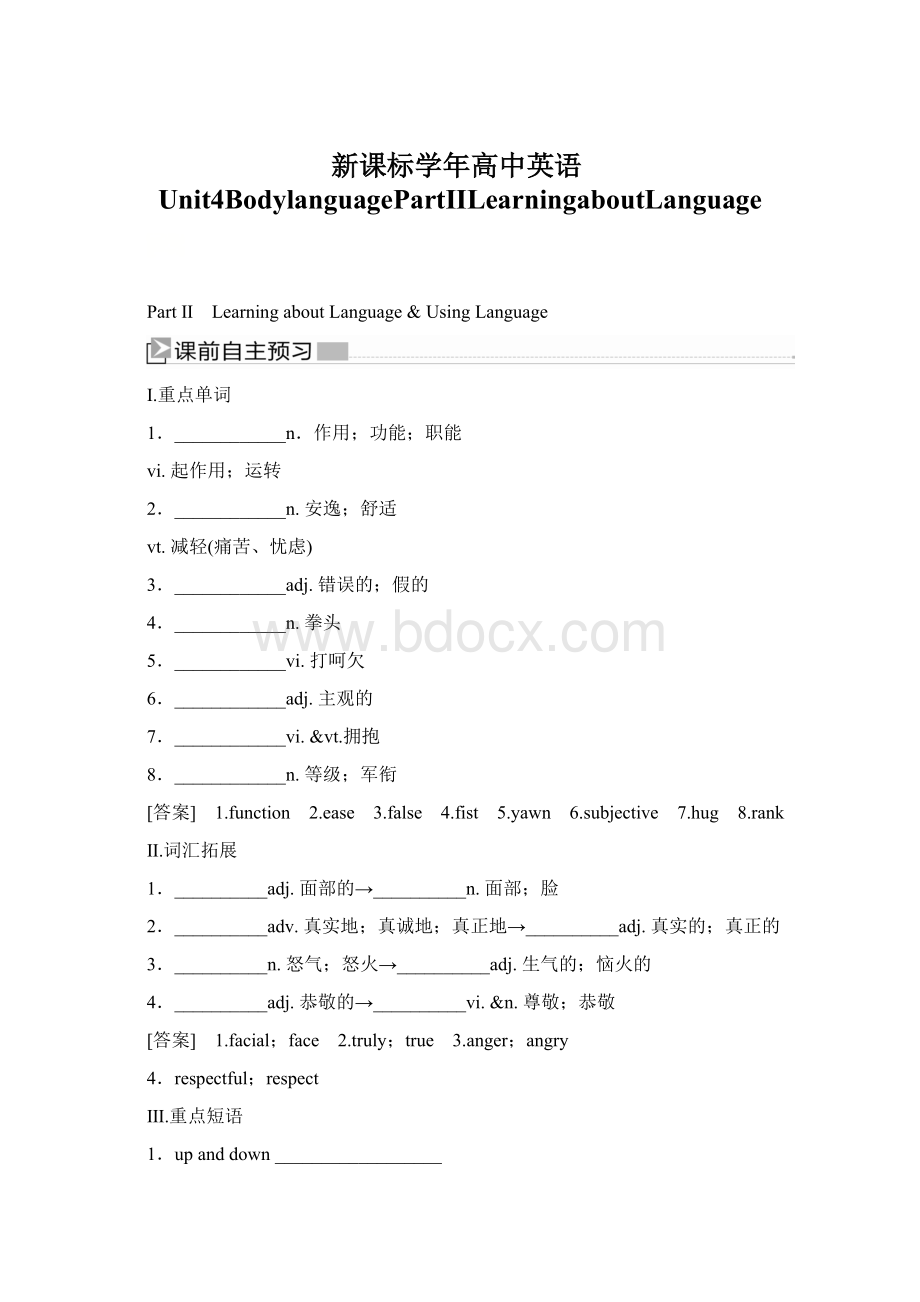新课标学年高中英语Unit4BodylanguagePartⅡLearningaboutLanguage.docx
《新课标学年高中英语Unit4BodylanguagePartⅡLearningaboutLanguage.docx》由会员分享,可在线阅读,更多相关《新课标学年高中英语Unit4BodylanguagePartⅡLearningaboutLanguage.docx(21页珍藏版)》请在冰豆网上搜索。

新课标学年高中英语Unit4BodylanguagePartⅡLearningaboutLanguage
PartⅡ LearningaboutLanguage&UsingLanguage
Ⅰ.重点单词
1.____________n.作用;功能;职能
vi.起作用;运转
2.____________n.安逸;舒适
vt.减轻(痛苦、忧虑)
3.____________adj.错误的;假的
4.____________n.拳头
5.____________vi.打呵欠
6.____________adj.主观的
7.____________vi.&vt.拥抱
8.____________n.等级;军衔
[答案] 1.function 2.ease 3.false 4.fist 5.yawn 6.subjective 7.hug 8.rank
Ⅱ.词汇拓展
1.__________adj.面部的→__________n.面部;脸
2.__________adv.真实地;真诚地;真正地→__________adj.真实的;真正的
3.__________n.怒气;怒火→__________adj.生气的;恼火的
4.__________adj.恭敬的→__________vi.&n.尊敬;恭敬
[答案] 1.facial;face 2.truly;true 3.anger;angry
4.respectful;respect
Ⅲ.重点短语
1.upanddown__________________
2.feelrelaxed__________________
3.loseface__________________
4.turnone'sbackto__________________
5.nodthehead__________________
6.摇头__________________
7.把目光从……上移开;不看__________________
8.在大多数情况下__________________
9.对某人尊重/尊敬__________________
10.拥抱某人__________________
[答案] 1.上上下下;来来回回 2.感觉放松 3.丢脸
4.背对;背弃 5.点点头 6.shakethehead
7.lookawayfrom 8.inmostcases 9.berespectfultosb. 10.giveahugtosb.
Ⅳ.重点句式
1.evenif引导让步状语从句
Itispossibleto“read”othersaroundus,______________theydonotintendforustocatchtheirunspokencommunication.
“读懂”我们周围的人(的心思)是有可能的,即使他们并不想让我们理解他们没有说出来的信息。
2.Howaboutdoingsth.“做……如何?
”句式
________________showingthatIambored?
如何来表示我很厌烦呢?
3.it用作形式主语,指代that从句的句式
...so____________________________weunderstandeachotheraswellaswedo!
……因此我们仍能做到彼此理解,这真是件令人惊奇的事!
[答案] 1.evenif 2.Howabout
3.itisanamazingthingthat
Ⅴ.课文理解
1.WhichofthefollowingaboutbodylanguageisTRUE?
A.Itismoreimportantthanspokenlanguage.
B.Itisasimportantasspokenlanguage.
C.Itisnotasimportantasspokenlanguage.
D.Itislessimportantthanspokenlanguage.
2.Whymayapersonsmileifhelosesface?
A.Toshowhisanger.
B.Tohidehisembarrassment.
C.Tothreatenothers.
D.Tolaughatothers.
3.Ifyouarenotinterestedinothers'talking,youmay__________.
A.lookawayfromhimoryawn
B.turntowardandlookatsomething
C.fixyourattentiononthespeaker
D.standatalittledistancewithopenhands
4.SupposeyouareateacherinAmerica,you'lltellyourstudentsto__________whenothersaretalking.
A.avoidlookingatothersdirectly
B.lookdirectlyatothers
C.glanceatothers
D.lookdownatothers
5.Wecaninferfromthetextthat__________.
A.Wecancommunicatesuccessfullywithothersusingbodylanguage
B.peoplefromdifferentcountrieswillnotmisunderstandeachotherusingbodylanguage
C.weshouldtrytolearnmoreaboutothercountries'customs
D.allaroundtheworld,peopleexpressthesameideasusingthesamebodylanguage
[答案] 1~5 BBABC
教材原文
SHOWINGOURFEELINGS
Bodylanguageisoneofthemostpowerfulmeansofcommunication,oftenevenmorepowerfulthanspokenlanguage.Peoplearoundtheworldshowallkindsoffeelings,wishesandattitudesthattheymightneverspeakaloud.Itispossibleto“read”othersaroundus,eveniftheydonotintendforustocatchtheirunspokencommunication.Ofcourse,bodylanguagecanbemisread,butmanygesturesandactionsareuniversal.
Themostuniversalfacialexpressionis,ofcourse,thesmile—itsfunctionistoshowhappinessandputpeopleatease.Itdoesnotalwaysmeanthatwearetrulyhappy,however.Smilesaroundtheworldcanbefalse,hidingotherfeelingslikeanger,fearorworry.Thereareunhappysmiles,suchaswhensomeone“losesface”andsmilestohideit.However,thegeneralpurposeofsmilingistoshowgoodfeelings.
Fromthetimewearebabies,weshowunhappinessorangerbyfrowning.Inmostplacesaroundtheworld,frowningandturningone'sbacktosomeoneshowsanger.Makingafistandshakingitalmostalwaysmeansthatsomeoneisangryandthreateninganotherperson.
Therearemanywaysaroundtheworldtoshowagreement,butnoddingtheheadupanddownisusedforagreementalmostworldwide.Mostpeoplealsounderstandthatshakingtheheadfromsidetosidemeansdisagreementorrefusal.
HowaboutshowingthatIambored?
Lookingawayfrompeople,oryawningwill,inmostcases,makemeappeartobeuninterested.However,ifIturntowardandlookatsomeoneorsomething,peoplefromalmosteveryculturewillthinkthatIaminterested.IfIrollmyeyesandturnmyheadaway,ImostlikelydonotbelievewhatIamhearingordonotlikeit.
Beingrespectfultopeopleissubjective,basedoneachculture,butingeneralitisprobablynotagoodideatogiveahugtoabossorteacher.Inalmosteveryculture,itisnotusuallygoodtostandtooclosetosomeoneofahigherrank.StandingatalittledistancewithopenhandswillshowthatIamwillingtolisten.
Withsomanyculturaldifferencesbetweenpeople,itisgreattohavesomesimilaritiesinbodylanguage.Wecanoftenbewrongabouteachother,soitisanamazingthingthatweunderstandeachotheraswellaswedo!
译文参照
表达我们的情感
身势语是最强有力的交流手段之一,甚至通常它比口头语言更有力量。
世界各地的人要表达各种情感、愿望和态度,他们可能从来不会大声地说出来。
“读懂”我们身边的人是有可能的,尽管他们并不想让我们捕捉到他们没有说出来的意思。
当然,身势语也会被误读,但是很多手势和举动都是具有普遍性的。
微笑当属最普遍使用的面部表情,它的作用是表示快乐和安人心境。
然而它并不总是代表着真正的快乐。
世界上的微笑可能是假象,来掩盖像生气、恐惧或担忧的情绪。
还有不愉快的微笑,比如说当某人丢脸时,他们用微笑来掩饰。
但是,微笑一般是用来表达好的情感的。
从婴儿时代开始,我们就用皱眉来表示不悦和生气。
在世界大部分地区,皱眉和背对着某人表示生气。
攥拳并晃动拳头几乎总是表示某人很生气并要威胁他人。
世界上有很多种表示同意的方式,但是上下点头表示同意几乎在全世界范围内适用。
大部分人也明白左右摇头是不同意或拒绝的意思。
怎么表示我很厌烦呢?
在多数情况下,把目光从人们身上移开或打呵欠,会使我看上去(对某物/人)不感兴趣。
然而,如果我转向某人或某物并看着他(它)的话,几乎每种文化背景下的人都会认为我对此感兴趣。
如果我转动眼睛,把头扭向一边,很可能就是我不相信或者不喜欢我所听到的。
在每种文化背景下,尊重他人是主观的,但是通常拥抱老板和老师可能会不妥当。
几乎在每一种文化背景下,和级别比自己高的人站得太近通常是不好的。
两手伸开,站得有一定距离表示我愿意聆听。
人们之间有那么多的文化差异,而身势语有一些相似之处是很好的。
我们经常会彼此误会,因此我们能做到相互理解是一件很令人惊奇的事情!
1
functionn.作用;(事物的)功能;职能;机能 vi.运转;起作用
[教材原句] Themostuniversalfacialexpressionis,ofcourse,thesmile—itsfunctionistoshowhappinessandputpeopleatease.
最普遍使用的面部表情当然是微笑——其作用是表示快乐和使人放松。
①Thefunctionofacash�machineistoprovidepeoplewithcashwhenthebankisshut.
自动取款机的功能是在银行关门后让人们提取现金。
②Inyournewjob,youwillbeexpectedtoperformmanydifferentfunctions.
在新的工作岗位上,你可要履行许多不同的职责。
③SomeEnglishadverbsfunctionasadjectives.
英语中有些副词可作形容词用。
functionas 起……作用;具有……功能
[即学即用]
单句语法填空
①Theybelievetheselectionismostlyaresultoftheir__________(function)indailylife.
②Itriedtoworkitout,butIhadbrainfreezeandcouldnot__________(function).
③Comparedtothetraditionalones,theyhavethreenewunique__________(function).
[答案] ①function(s) ②function ③functions
2
angern.怒气;怒火 vt.使发怒,激怒
[教材原句] Smilesaroundtheworldcanbefalse,hidingotherfeelingslikeanger,fearorworry.
世界上的微笑可能是假的,用来掩饰其他情绪,比如生气、害怕和烦恼。
①Hermotherhardlyevershoutedatherin/withanger.
她的母亲几乎从来不怒气冲冲地对她喊叫。
②Shewasangrywithhimforsayingso.
她因他这样说而生他的气。
③Hewasangryabout/atthehurt.
他因受到伤害而发怒。
(1)in/withanger 愤怒地;生气地
(2)angryadj.生气的;发怒的
beangrywithsb.for...因……生某人的气
beangryat/aboutsth.因某事而生气
angrilyadv.生气地
[即学即用]
完成句子
①Themostawkwarde�mailmistakeisusuallycommitted________________.
最尴尬的电子邮件错误通常会使人生气。
②Heglared__________atherbutdidn'tsayaword.
他生气地瞪着她,但没说一句话。
[答案] ①inanger ②angrily
1
atease舒适;快活;自由自在
[教材原句] Themostuniversalfacialexpressionis,ofcourse,thesmile—itsfunctionistoshowhappinessandputpeopleatease.
最普遍使用的面部表情当然是微笑,它的作用是表示快乐和安人心境。
①Ifeltthathewasnotateasewithwhathehadprepared.
我感到他对原来准备好的内容有点局促不安。
②Weliveinanagewhenmoreinformationisavailablewitheasethaneverbefore.
我们生活在这样一个时代,更多的信息比以往更容易获取。
③Walkinghelpstoeasehimofhispain.
散步有助于减轻他的疼痛。
(1)feel/lookatease 感到/看上去心情放松
withease轻易地;毫不费力地
putsb.atease使某人放松
takeone'sease休息;轻松一下
(2)easesb.ofsth.减轻某人的(痛苦、负担等)
easeone'smind使某人安心
[即学即用]
完成句子
①Hehandedheracupofcoffeeto________________________.
他递给她一杯咖啡,让她放松下来。
②Ifeelcompletely________________withhim.
我跟他在一起感到无拘无束。
③Johnhasbeenworkinghardallthesedays,sohepassedtheexam________________.
约翰最近一直努力学习,所以他轻易地通过了这次考试。
[答案] ①putheratease ②atease ③withease
2
loseface丢脸;丢面子
[教材原句] Thereareunhappysmiles,suchaswhensomeone“losesface”andsmilestohideit.
还有不愉快的微笑,比如当某人“丢了面子”时就会用微笑来掩饰。
①Don'tbeafraidtoloseface;makingmistakesispossibleandcommon.
不要害怕丢面子,犯错误是难免的而且是普遍现象。
②Hedidn'tadmithismistakesinordertosavefaceinpublic.
为了在公众场合下保全面子他不承认错误。
③Weshouldkeepcalminthefaceofdanger.
面对危险我们应该保持镇静。
(1)makeaface/faces 做鬼脸
saveface保全面子;有脸面
inthefaceof面对……;在……面前
tosb.'sface当着某人的面
facetoface面对面;相对
(2)faceupto正视;勇敢面对
befacedwith面对……;面临……
巧学助记
Yesterday,JimtookTom'spen,asaresult,thepenwasrecognizedbyTom.Inthefaceofhisclassmates,Jimthoughthelostface.Inordertosavehisface,hedecidedtotalkwithTomfacetoface.However,Tomaskedhimtoapologizetothewholeclass'sface.
昨天,吉姆拿了汤姆的钢笔,结果,钢笔被汤姆认出来了。
面对同学,吉姆觉得丢脸。
为了挽回面子,他决定当面与汤姆谈谈,但是,汤姆让他当着全班同学的面道歉。
[即学即用]
完成句子
①________________________________(为了不丢脸),
hespentthewholenightpreparingforthespeechforthenextday.
②Marywas________________(做鬼脸)atmethroughthewindow.
③Youhadbetterhaveatalkwithhim__________________(面对面地).
④Whenyouarechattingwithone,please___________(直视他).
[答案] ①Inordernottoloseface ②makingaface
③facetoface ④lookhimintheface
3
turnone'sbackto背对;背弃;对……置之不理
[教材原句] Inmostplacesaroundtheworld,frowningandturningone'sbacktosomeoneshowsanger.
在世界上大多数地方,皱眉和背对着某人都表示发怒。
①Whenyouspeaktosomeone,don'tturnyourbacktohim.
当你跟别人谈话时,不要背对着他。
②Idon'tunderstandwhyJohnturneddownMary'skindoffer.
我不明白约翰为什么拒绝玛丽善意的帮助。
③Ican'theartheradioverywell.Couldyouturnitupabit?
收音机我听不太清楚。
你把声音开大点行吗?
turndown 拒绝;调低音量
turnup出现;到场;调大音量
turnon打开
turnoff关掉
turnout结果;证明是
turnto向……求助;转向
turnover打翻;翻阅;反复思考
[即学即用]
完成句子